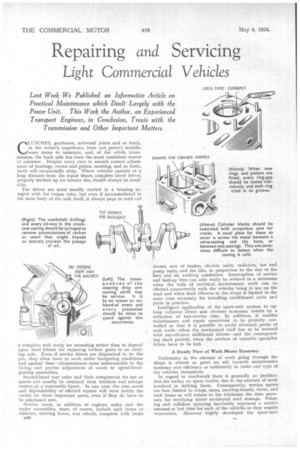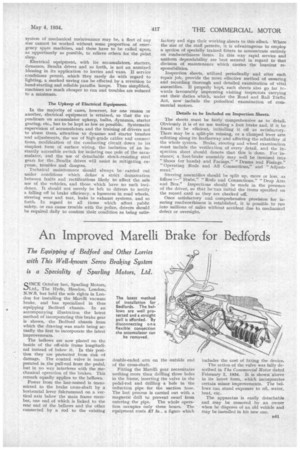Repairing and Servicing Light Commercial Vehicles Last Week We Published
Page 54

Page 55

If you've noticed an error in this article please click here to report it so we can fix it.
an Informative Article on Practical Maintenance which Dealt Largely with the Power Unit. This Week the Author, an Experienced Transport Engineer, in Conclusion, Treats with the
Transmission and Other Important Matters
CLUTCHES, gearboxes, universal joints and so forth, in the writer's experience, have not proverl troublesome items to maintain, and, of the whole transmission, the back axle has been the most consistent source of nuisance. Despite every care to sustain correct adjustment of bearings, crown and pinion meshing, and so forth, teeth will occasionally strip. Where vehicles operate at a long distance from ihe repair depot, complete bevel drives, properly meshed up for instant use, should always be available.
• The drives are most usually carried in a housing integral with the torque tube, but even if accommodated in the main body of the axle itself, it always pays to send out
a complete unit ready for mounting rather than to depena upon local labour for replacing broken gears in an existing axle. Even if service fitters are dispatched to do the job, they often have to work under hampering conditions and against time—circumstances most unfavourable to the fitting and precise adjustment of worm or spiral-bevelgearing assemblies.
Second-hand rear axles and their components for use as spares can usually be obtained from breakers and salvage dealers at a reasonable figure. In any case, the time saved and dependability of effected repairs will soon justify the outlay on these important parts, even if they do have to be purchased new.
Service stock, in addition to engines, axles, and the major assemblies, must, of course, include such items as clutches, steering boxes, rear wheels, complete with brake MO drums, sets of brakes, electric units, radiators, fan and pump units, and the like, in proportion to the size of the fleet and its working conditions. Interruption of service and laid-up time can only really be reduced to a minimum when the bulk of technical maintenance work can be effected concurrently with the vehicles being in use on the road and when their idleness in the shops is limited to the mere time necessary for installing conditioned units and parts in position. Intelligent application of the spare-unit system to upkeep achieves direct and obvious economic results by a reduction of lost-service time. In addition, it enables maintenance and repair operations to be properly con• trolled so that it is possible to avoid alternate peaks of rush work—when the mechanical staff has to be watered with sub-efficient additional labour—and the corresponding slack periods, when the services of valuable specialist fitters have to be lost.
A Steady Flow of Work Means Economy.
Uniformity in the amount of work going through the shops is almost as great an aid towards maintenance economy and efficiency as uniformity in make and type of the vehicles themselves.
In regard to coachwork there is generally no justification for outlay on spare bodies, due to the amount of work involved in shifting them. Consequently, service spares are best limited to wings, stays, sunning-boards, doors, and such items as will reduce to the minimum the time necessary for rectifying minor accidental road damage. Painting and cellulose spraying inevitably represent a certain amount of lost time for each of the vehicles as they require renovation. However highly developed the spare-unit system of mechanical maintenance may be, a fleet of any size cannot be worked without some proportion of emergency spare machines, and these have to be called upon, as opportunely as possible, to relieve others for the paint shop.
Electrical equipment, with its accumulators, starters, dynamos, Bendix drives and so forth, is not an unmixed blessing in its application to lorries and vans. If service conditions permit, which they rarely do with regard to lighting, a marked saving can be effected by a reversion to hand-starting and reliable paraffin lamps. Thus simplified, machines are much cheaper to run and troubles are reduced to a minimum.
The Upkeep of Electrical Equipment.
In the majority of cases, however, for one reason or another, electrical equipment is retained, so that the expenditure on accumulator upkeep, bulbs, dynamos, starter gearing, etc., has to be kept as low as possible. Systematic supervision of accumulators and the training of drivers not to abuse them, attention to dynamo and starter brushes and adjustments, the use of high-grade cables and connections, modification of the conducting circuit down to its simplest form of surface wiring, the inclusion of an instantly accessible switch for isolating one pole of the accumulator, and the use of detachable shock-resisting steel gears for the. Bendix drives will assist in mitigating ex
pense, troubles and dangers. •
Technical maintenance should always be carried out under conditions which define a strict demarcation between faults and rectifications likely to affect the safe use of the vehicles, and those which have no such incidence. It should not merely be left to drivers to notify a falling off in brake efficiency, a looseness in road wheels, steering wear and tear, leaks in exhaust systems, and so forth. In regard to all items which affect public safety, or can cause trouble with the police, drivers should be required daily to confirm their condition as being satis
factory and sign their working sheets to this effect.. Where the size of the staff permits, it is advantageous to employ a section of specially trained fitters to concentrate entirely on roadworthiness items. In this way rapid service and uniform dependability are best secured in regard to that division of maintenance which carries the heaviest responsibilities.
Inspection sheets, utilized periodically and after each repair job, provide the most effective method of ensuring and recording thorough and detailed examination of vital assemblies. If properly kept, such sheets also go far towards favourably impressing visiting inspectors carrying out their duties which, under the Road and Rail Traffic Act, now include the periodical examination of commercial motors.
Details to be Included on Inspection Sheets.
The sheets must be fairly comprehensive as to detail. Obviously it is of no use testing a foot brake and, if it be found to be efficient, initialling it off as satisfactory. There may be a split-pin missing, or a clamped lever arm splitting along its featherway and affecting the reliability sf the whole system. Brake, steering and wheel examination must include the verification of every detail, and the inspection sheet should denote that this is done. For instance; a foot-brake assembly may well be itemized into "Shoes (or bands) and Facings," Drums and Fixings," "Operating Rods and All Connections," and Adjustment."
Steering assemblies should be split up, more or less, as follow:—" Stubs," "Rods and Connections," "Drop Arm and Box." Inspections should be made in the presence of the driver, so that he'scan initial the items specified on the record card as they are checked off.
Once satisfactory and comprehensive provision for insuring roadwoithiness is established, it is possible to run into millions of miles without accident due to mechanical defect or oversight.




























































































